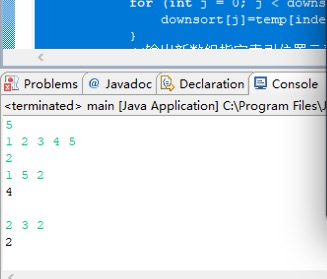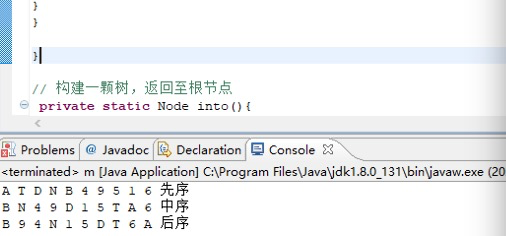|这个作业属于哪个课程| https://edu.cnblogs.com/campus/zswxy/2018SE/|
|----|----|----|
|这个作业要求在哪里| https://edu.cnblogs.com/campus/zswxy/2018SE/homework/11406/|
|这个作业的目标| 寻找数组中第K大是哪个数 二叉树的先、中、后 序遍历与层级遍历|
|学号| 20189744|
|其他参考文献| b站,百度,博客园|
题目一:寻找数组中第K大是数 考察算法:排序算法
解题思路:对这个乱序数组按照从大到小先行排序,然后取出前k大,总的时间复杂度为O(n*logn + k)。
代码
package zy;
import java.util.Arrays;
import java.util.Scanner;
public class main{
public static void main(String[] args) {
Scanner sc = new Scanner(System.in);
int n =sc.nextInt();
int arr[] = new int[n];
for (int i = 0; i < arr.length; i++) {
arr[i] = sc.nextInt();//给定的序列
}
int p = sc.nextInt();//输入询问个数
for (int i = 0; i < p; i++) {
int l = sc.nextInt();
int r = sc.nextInt();
int k = sc.nextInt();//输入指定K
int temp[] = new int[r-l+1];
int index=0;
//将指定范围元素赋给新的数组
for (int j = l-1; j <= r-1; j++) {
temp[index++]=arr[j];
}
Arrays.sort(temp);//指定范围元素的新数组进行排序
int downsort[] = new int[temp.length];
int index2 = temp.length-1;
//按照倒叙的方式赋予下一个新数组
for (int j = 0; j < downsort.length; j++) {
downsort[j]=temp[index2--];
}
//输出新数组指定索引位置元素
System.out.println(downsort[k-1]);
}
}
}

题目二:二叉树的先、中、后 序遍历与层级遍历
解题思路:
先序遍历:第一次经过这个结点的时候访问。
中序遍历,第二次经过这个结点的时候访问了结点,就是从左孩子返回的这个箭头的时候访问。
后序遍历,第三次经过这个结点的时候访问。就是从右孩子返回的这个箭头的时候访问。
层序遍历,按照一层一层的顺序,从左到右。
package zy;
import java.util.LinkedList;
public class m {
public static void main(String[] args) {
// TODO 自动生成的方法存根
/*
作业要求:叉树的先、中、后 序遍历与层级遍历
自己实现四个方法,Tree01方法中调用,将结果打印到控制台
*/
/* 二叉树的结构
A
/ \
T 6
/
D
/ \
N 5
/ \ /
B 4 1
\
9
*/
Node root = into();
// 先序遍历
A(root);
System.out.println("先序");
// 中序遍历
B(root);
System.out.println("中序");
// 后序遍历
C(root);
System.out.println("后序");
// 层级遍历
D(root);
System.out.println("层级");
}
private static void A(Node tree) {
// TODO 先序遍历
if (tree != null) {
System.out.print(tree.data + " ");
A(tree.l);
A(tree.r);
}
}
private static void B(Node tree) {
// TODO 中序遍历
if (tree != null) {
B(tree.l);
System.out.print(tree.data + " ");
B(tree.r);
}
}
private static void C(Node tree) {
// TODO 后序遍历
if (tree != null) {
C(tree.l);
C(tree.r);
System.out.print(tree.data + " ");
}
}
private static void D(Node tree) {
// TODO 层级遍历
if (tree != null) {
LinkedList<Node> linkedList = new LinkedList<Node>();
//将根节点列入到List中
linkedList.offer(tree);
Node node = null;
while (!linkedList.isEmpty()) {
//移除列表中的一个元素,返回元素值
node = (Node) linkedList.pop();
System.out.print(node.data + " ");
if (node.l != null) {
//将出队结点的左子树根入队
linkedList.offer(node.l);
}
if (node.r != null) {
//将出队结点的右子树根入队
linkedList.offer(node.r);
}
}
}
}
// 构建一颗树,返回至根节点
private static Node into(){
Node root = new Node("A");
Node node1 = new Node("T");
Node node2 = new Node("D");
Node node3 = new Node("N");
Node node4 = new Node("B");
Node node5 = new Node("6");
Node node6 = new Node("5");
Node node7 = new Node("4");
Node node8 = new Node("9");
Node node9 = new Node("1");
root.l = node1;
node1.l = node2;
node2.l = node3;
node2.r = node6;
node3.r = node7;
node7.r = node8;
node6.l = node9;
node3.l = node4;
root.r = node5;
return root;
}
// 节点
static class Node{
// 数据
Object data;
// 左孩子
Node l;
// 右孩子
Node r;
public Node(){}
public Node(Object data) {
this.data = data;
this.l = null;
this.r = null;
}
public Node(Object data, Node l, Node r) {
this.data = data;
this.l = l;
this.r = r;
}
}
}





